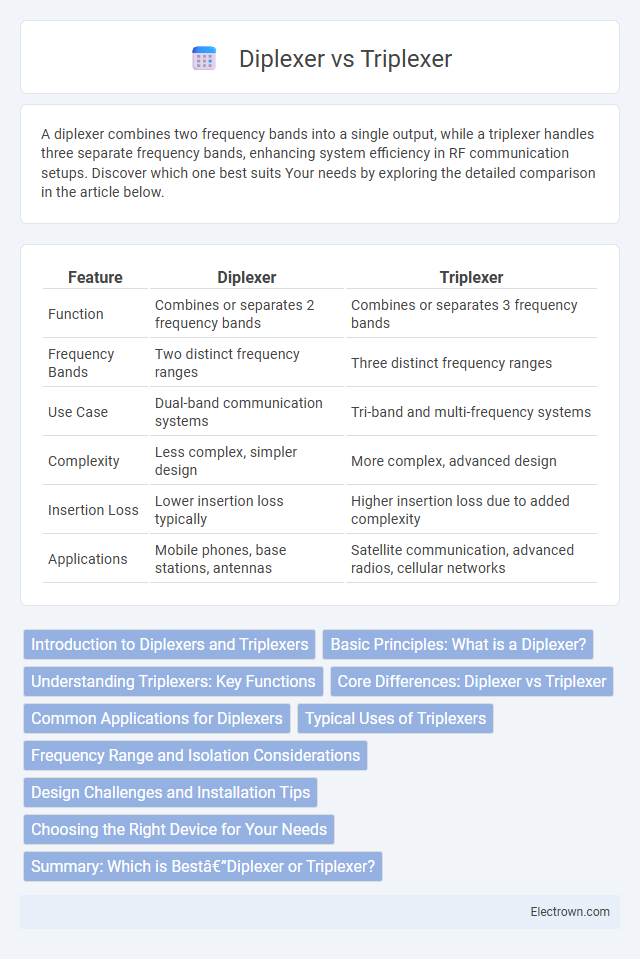A diplexer combines two frequency bands into a single output, while a triplexer handles three separate frequency bands, enhancing system efficiency in RF communication setups. Discover which one best suits Your needs by exploring the detailed comparison in the article below.
Table of Comparison
| Feature | Diplexer | Triplexer |
|---|---|---|
| Function | Combines or separates 2 frequency bands | Combines or separates 3 frequency bands |
| Frequency Bands | Two distinct frequency ranges | Three distinct frequency ranges |
| Use Case | Dual-band communication systems | Tri-band and multi-frequency systems |
| Complexity | Less complex, simpler design | More complex, advanced design |
| Insertion Loss | Lower insertion loss typically | Higher insertion loss due to added complexity |
| Applications | Mobile phones, base stations, antennas | Satellite communication, advanced radios, cellular networks |
Introduction to Diplexers and Triplexers
Diplexers and triplexers are passive RF devices that combine or separate multiple frequency bands into a single antenna system. A diplexer manages two frequency bands, while a triplexer handles three, enabling more efficient spectrum utilization and signal routing. Choosing the right device depends on your system's complexity and the number of frequency bands you need to integrate.
Basic Principles: What is a Diplexer?
A diplexer is a radio frequency device that combines or separates two different frequency bands through a single coaxial cable or antenna without interference. It operates by using filters to isolate signals, allowing simultaneous transmission or reception of two signals over one path. Diplexers are commonly used in communication systems to enable efficient utilization of antenna infrastructure.
Understanding Triplexers: Key Functions
Triplexers are multi-port devices that separate or combine signals across three distinct frequency bands, enabling efficient signal management in communication systems. Unlike diplexers, which handle two frequency bands, triplexers offer enhanced flexibility for applications requiring simultaneous transmission or reception on multiple channels. Your network can benefit from triplexers by improving signal isolation, reducing interference, and optimizing bandwidth utilization across diverse frequency ranges.
Core Differences: Diplexer vs Triplexer
Diplexers separate or combine signals into two frequency bands, typically used in applications requiring two-way radio or TV signal management. Triplexers extend this functionality by handling three frequency bands simultaneously, enabling connection of three different antennas or transceivers to one system. The core difference lies in the number of frequency bands managed, with diplexers supporting two and triplexers supporting three, impacting complexity, size, and signal isolation requirements.
Common Applications for Diplexers
Diplexers are commonly used in communication systems to combine or separate signals operating at different frequency bands, such as in satellite TV setups where they enable the simultaneous use of a single cable for both TV and internet signals. They are essential in RF systems to allow transmission and reception on the same antenna without interference. Common applications also include cellular base stations, where diplexers manage multiple frequency bands for efficient spectrum utilization.
Typical Uses of Triplexers
Triplexers are typically used in communication systems to separate or combine three different frequency bands, enabling efficient use of a single antenna for multiple signals. Common applications include cellular base stations, satellite communications, and amateur radio setups where simultaneous transmission and reception on different frequencies are necessary. Your network can benefit from triplexers by improving signal management and reducing hardware costs compared to separate antennas.
Frequency Range and Isolation Considerations
Diplexers and triplexers differ primarily in frequency range and isolation capabilities, with diplexers designed to separate or combine two frequency bands and triplexers handling three distinct bands. Diplexers typically provide higher isolation between two bands due to simpler filtering requirements, reducing interference and signal degradation. Your choice between them should consider the specific frequency ranges involved and the required isolation levels to ensure optimal system performance.
Design Challenges and Installation Tips
Diplexers and triplexers both combine multiple signals into one antenna feed but differ in complexity and design challenges, with triplexers requiring more precise filtering to prevent signal interference among three frequency bands. Installation of diplexers is generally straightforward, yet triplexer setup demands careful attention to cable lengths and connector quality to maintain signal integrity across all bands. You should ensure proper grounding and use high-quality components to minimize insertion loss and avoid cross-band interference during installation.
Choosing the Right Device for Your Needs
Choosing between a diplexer and a triplexer depends on the number of frequency bands you need to combine or separate in your system. A diplexer handles two frequency bands, ideal for simpler applications, while a triplexer manages three bands, offering greater versatility for complex setups. Your choice should align with the specific frequency requirements and the complexity of your communication or broadcasting system.
Summary: Which is Best—Diplexer or Triplexer?
A diplexer is ideal for combining or splitting two frequency bands, while a triplexer manages three separate frequency bands, making it better for more complex systems requiring multiple signal paths. The choice depends on system requirements: diplexers offer simpler design and lower cost for dual-band applications, whereas triplexers provide greater flexibility and efficiency in multi-band communications. For systems needing to handle three distinct signals simultaneously, a triplexer is typically the best solution.
Diplexer vs triplexer Infographic

 electrown.com
electrown.com